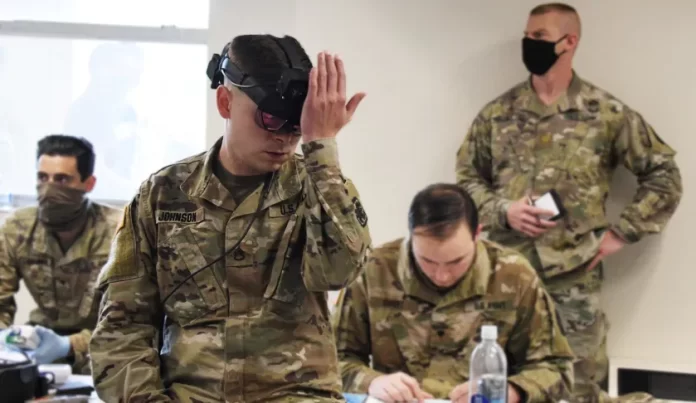“Weaving Health: The U.S. Army’s Integration of Smart Textiles and Wearable Sensors for COVID-19 Detection”**
Hello, textile enthusiasts! Today, let’s dive into the intriguing world where textiles meet technology and learn about the US Army’s innovative endeavor — developing wearable sensors to detect coronavirus symptoms. This initiative isn’t just a leap forward in wearable tech but a testament to how far smart textiles have come. Let’s explore the fascinating details, understand some key concepts, and see how this endeavor is geared to transform health monitoring in the military and beyond.
The Mission for Wearable Innovation
The US Army has put forth a bold call to technology companies to create wearable sensors capable of detecting early symptoms of COVID-19. This initiative begins with a substantial $25 million contract accentuating the need for rapid and accurate diagnostics to help isolate pre-symptomatic cases and prevent virus spread among service members. The urgency and scale of this effort underscore the critical role of wearable technology and smart textiles in safeguarding health and operational readiness.
Understanding Wearable Sensors
The crux of this technological marvel lies in wearable sensors — devices that seamlessly integrate into everyday clothing or accessories to monitor physiological data. Imagine a sensor nestled within a shirt, wristband, or belt that keeps a vigilant eye on your health. The Army’s task is to harness existing technology to deliver real-time indicators like fever detection, respiratory difficulties, identification of “molecular biomarkers,” and antibody presence.
Smart Textiles:** These are fabrics embedded with digital components and electronics such as sensors and microprocessors. These textiles can collect data and react to environmental conditions or user interaction, making them invaluable in health monitoring and numerous other applications.
Biomarkers:** These are measurable indicators of some biological state or condition. In the context of COVID-19, biomarkers might include specific proteins or molecular changes indicating infection.
The Revolutionary Integration
One of the hallmarks of this program is its basis in existing military technology adapted for health monitoring. Take, for example, the Integrated Visual Augmentation System (IVAS), a sophisticated pair of battlefield goggles. Initially designed with a suite of heat and low light sensors alongside a robust software application from Microsoft, these goggles are now pivoted to measure body temperatures efficiently.
Picture this: an impressive tech marvel that can screen the temperatures of 300 personnel in just 25 minutes. Such efficiency can revolutionize initial health screening processes in places like military bases, public transport hubs, and airports where large-scale, rapid checks are critical.
The Importance of Rapid Adaptation
Adapting military-grade technology for health monitoring might sound complex, but it’s an excellent example of innovation under pressure. Tom Bowman, one of the project managers, highlighted this synergy by demonstrating how digital thermal sensors could be quickly modified. Within four days, a new software application was integrated, allowing the IVAS goggles to measure body temperatures from a safe distance.
Applications Beyond the Army
Let’s stretch our imagination to envision the broader applicability of such innovations. In the civilian realm, these technologies could redefine public health management. For instance, infrared sensors installed at the Pentagon — designed to screen thousands of individuals swiftly — could be implemented in our schools, offices, and event venues to bolster our defenses against potential outbreaks.
The Potential of Smart Textiles in Everyday Life
One can’t help but be excited about the expansive potential of smart textiles. These textiles not only find a crucial place in defense but have already begun trickling into civilian life. Imagine wearing a shirt that can monitor your vital statistics, providing updates and alerts via a connected device. For patients with chronic diseases or athletes looking to optimize performance, smart textiles represent the future of personal health monitoring.
Flexible Electronics:** An essential component of smart textiles, these are circuits built on flexible substrates, making them resilient and adaptable to our daily movements.
The Future of Health Monitoring
As the boundaries of smart textiles continue to expand, we stand on the cusp of a revolution in how we monitor and respond to health conditions. With aspirations of integrating even more advanced diagnostics — perhaps sensing environmental hazards or biochemical changes — the fabric of our clothing might soon become the foremost line of defense in health monitoring.
The military’s call to action has set a new benchmark, urging the technology and textiles sectors to join forces in charting this brave new world. The wearable sensors being developed today promise to enhance not just the safety of the armed forces but, ultimately, global public health resilience.
Crossing Interdisciplinary Borders — Collaboration is Key
Perhaps the most exhilarating aspect of this journey is the collaboration across disciplines. Engineers, medical professionals, textile experts, and technologists are all coming together to create something revolutionary. This collaboration highlights the essential nature of interdisciplinary innovation.
Conclusion: Textile and Tech— A Synergy for the Future
In conclusion, the US Army’s initiative to develop wearable sensors for detecting COVID-19 symptoms is more than a timely response to a pressing issue; it’s a glimpse into the future of textiles, technology, and health monitoring. This initiative leverages smart textiles’ capabilities, adapting military technology for lifesaving applications, and promises transformative impacts on both military and civilian lives.
As we continue to observe and participate in these advancements, let’s remember how crucial textiles are — not just as threads and fabric but as the potential saviors of tomorrow, interwoven with technology in the most literal and life-saving ways. Stay tuned, textile enthusiasts, because the future is fabric, and it’s smarter than ever before!
Keywords: Wearable sensors, Smart textiles, US Army, (Post number: 194), COVID-19 detection, Health monitoring





